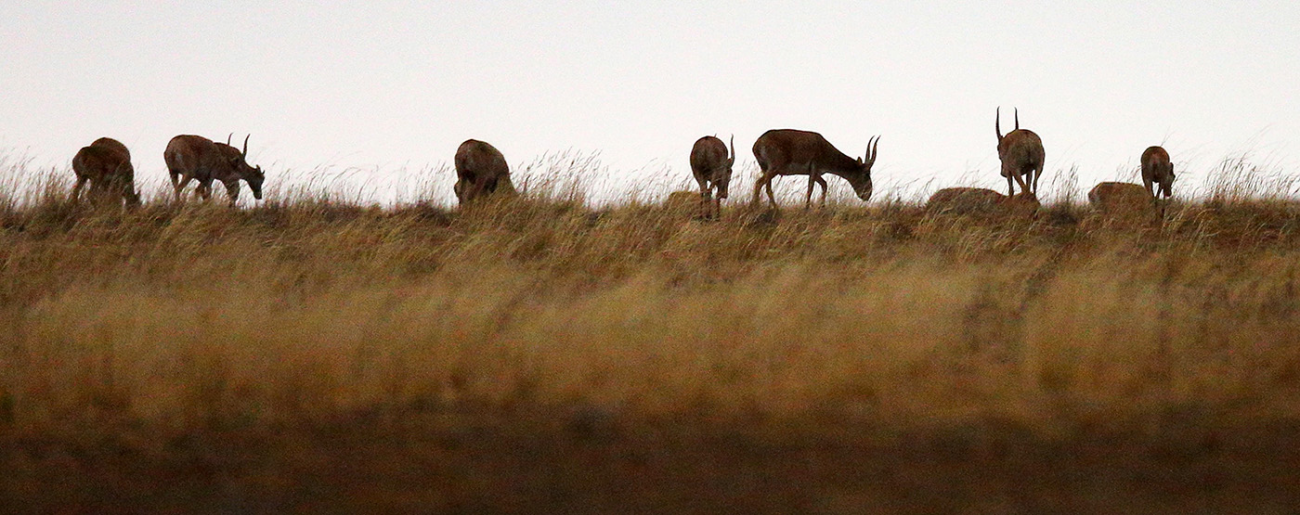
The Russian Ministry of Natural Resources plans to leave only one population of saigas in the Red Book of the Russian Federation - the Northwestern Caspian. However, this does not mean that ordinary Russians will be allowed to hunt the rest of the animals, as special teams will be involved. Academician of the Russian Academy of Sciences Vyacheslav Vladimirovich Rozhnov, head of the saiga study program, told RTVI journalists about this.
A Million Alien Saigas
Until July 4, 2025, the federal portal of draft regulatory legal acts is reviewing a draft order, which specifies that only the saiga population (Saiga tatarica) of the North-West Caspian region, which lives mainly in Kalmykia and the Astrakhan region, will remain under state protection. The previous version of the order did not contain this clarification.
In the explanatory note to the draft order, the need to clarify the protected population is explained by the damage that saigas cause to agriculture by migrating from Kazakhstan to Russia, as well as the risk of infectious diseases (foot-and-mouth disease, lumpy skin disease, anthrax, brucellosis, plague of small ruminants) being brought into the country. According to the Ministry of Natural Resources, since 2023, tens of thousands of saigas have been entering the left bank of the Volgograd and Saratov regions.
“Since the beginning of the year, about 400-500 thousand individuals have entered the territory of the Saratov region from the territory of Kazakhstan, their number continues to increase and currently the number of saiga in the Saratov region is estimated at around 1 million individuals,” the explanatory note says.
In addition to the population of the North-West Caspian region, there are two more saiga populations in Russia: the Volga-Ural and Betpak-Dala. According to Academician Vyacheslav Rozhnov, they are not actually Russian, since they live mainly on the territory of Kazakhstan and only at the edge of their range enter the territory of several regions of Russia - the Saratov, Volgograd and Astrakhan regions (Volga-Ural population) and the Orenburg region (Betpak-Dala population).
"They enter about 10-15 kilometers deep into the country, and in doing so they cause enormous damage to those who are engaged in agriculture. The ecological capacity of the territory does not accommodate such a number of saigas. That is why it’s been decided to restore order here, that is, to preserve only our own country’s population, which is isolated and exists only on the territory of Russia," explains Vyacheslav Rozhnov.
Only Russian saigas will be protected
“The protection of other saiga populations should be the responsibility of the countries where these animals primarily live, in the case of the Volga-Ural and Betpak-Dala saiga populations, this is the responsibility of Kazakhstan”, Rozhnov believes.
“Their population has grown enormously - today, according to their estimates, there are about four million saigas in Kazakhstan, and they cause damage there too. That is why Kazakhstan removed saigas from the protected species list and began normal use of this species,” the scientist says.
Rozhnov does not see a problem in the fact that a specific saiga population will be listed in the Red Book of the Russian Federation, since there is no need to protect such a large number of animals coming from Kazakhstan, which also cause damage to agriculture.
In the Saratov Region alone, saigas migrating en masse from Kazakhstan have caused damage to agriculture worth 169 million rubles, reported Deputy Minister of Agriculture of the region Igor Gridnev.
Special teams for culling
The fact that a specific population will remain under protection means that the numbers of other populations will be regulated by shooting, Rozhnov added.
“This does not mean that they are being hunted. This means that special state teams must be created that will have to remove a certain number of saigas so as not to harm the group that has entered Russian territory,” the expert explains.
Such teams will be created, if necessary, by regional authorities in each subject of the Russian Federation where there is a saiga problem. “Today we are talking only about the Saratov Region, because that is where the catastrophe is currently taking place,” Rozhnov noted.
It is difficult to say yet how many saigas will have to be shot. Local governments will have to count how many animals are in their region in order to determine how much their numbers need to be reduced, the expert adds. At the same time, all saigas in Russia remain listed in the Red Book and their shooting is prohibited by law.
